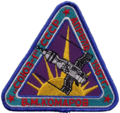Template:Selected anniversaries/April 24: Difference between revisions
Jump to navigation
Jump to search
No edit summary |
No edit summary |
||
| Line 7: | Line 7: | ||
||Robert-Aglaé Cauchoix born ... optician and instrument maker, whose lenses played a part in the race of the great refractor telescopes in the first half of the 19th century. Pic: observatory. | ||Robert-Aglaé Cauchoix born ... optician and instrument maker, whose lenses played a part in the race of the great refractor telescopes in the first half of the 19th century. Pic: observatory. | ||
||1879: Felix Ehrenhaft born ... physicist who contributed to atomic physics, to the measurement of electrical charges and to the optical properties of metal colloids. He was known for his maverick and controversial style. Pic. | ||1879: Felix Ehrenhaft born ... physicist who contributed to atomic physics, to the measurement of electrical charges and to the optical properties of metal colloids. He was known for his maverick and controversial style. Pic. | ||
| Line 65: | Line 63: | ||
||2000: George Michael Volkoff dies ... physicist and academic who helped, with J. Robert Oppenheimer, predict the existence of neutron stars before they were discovered. Pic. | ||2000: George Michael Volkoff dies ... physicist and academic who helped, with J. Robert Oppenheimer, predict the existence of neutron stars before they were discovered. Pic. | ||
</gallery> | </gallery> | ||
Revision as of 21:27, 26 January 2022
1656: Mathematician and physicist Thomas Fincke dies. He introduced the modern names of the trigonometric functions tangent and secant.
1914: The Franck–Hertz experiment, a pillar of quantum mechanics, is presented to the German Physical Society.
1967: Cosmonaut Vladimir Komarov dies in Soyuz 1 when its parachute fails to open. He is the first human to die during a space mission.


